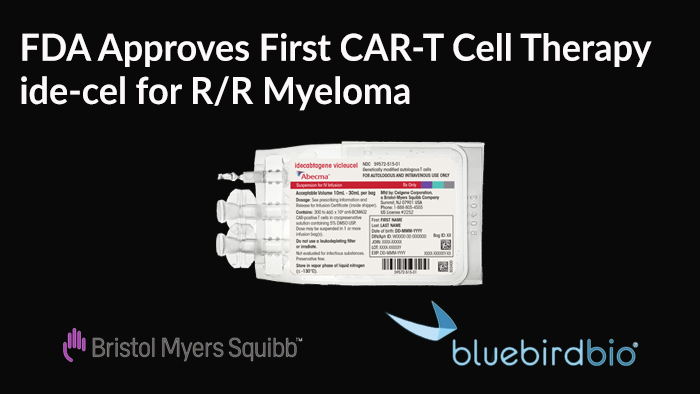The U.S. Food and Drug Administration Approved Bristol Myers Squibb’s and bluebird bio’s Abecma (idecabtagene vicleucel) (ide-cel), On Friday March 26th. Ide-cel is the first anti-BCMA CAR T cell therapy for relapsed or refractory multiple myeloma. The treatment was approved for patients with relapsed or refractory multiple myeloma after four or more prior lines of therapy, including an immunomodulatory agent, a proteasome inhibitor, and an anti-CD38 monoclonal antibody.
Additional Reading: What are CAR-Ts?
Abecma is a first-in-class BCMA-directed personalized immune cell therapy delivered as a one-time infusion for triple-class exposed patients with multiple myeloma
The FDA approval of Abecma is based on data from the pivotal Phase II KarMMa trial of 127 patients with relapsed or refractory multiple myeloma who had received at least three prior lines of therapy including an immunomodulatory agent, a proteasome inhibitor and an anti-CD38 antibody. The efficacy evaluable population consists of 100 patients who received Abecma within the dose range of 300 to 460 x 106 CAR-positive T cells. Of these patients, 88% received four or more prior lines of therapy and 85% were triple-class refractory.1
In the pivotal KarMMa trial, the majority (72%) of patients achieved rapid, deep and durable responses1
In the study, the overall response rate (ORR) for the efficacy evaluable population (n=100) was 72% (95% CI: 62-81), and 28% of patients achieved a stringent complete response (sCR; 95% CI: 19-38).1 Responses were rapid and durable, with a median time to response of 30 days (range: 15 to 88 days) and median duration of response of 11 months (95% CI: 10.3 – 11.4) for all responders and 19 months (95% CI: 11.4 – NE) for those who achieved sCR. Of the 28 patients who achieved sCR, an estimated 65% (95% CI: 42% – 81%) had remission lasting at least 12 months.1
In patients treated with Abecma in the KarMMa study, the safety profile was well-established with mostly low-grade occurrence of cytokine release syndrome (CRS) and neurotoxicity (NT), and predictable early onset and resolution. CRS of any grade occurred in 85% (108/127) of patients using the Lee grading system.1,2 Grade >3 CRS occurred in 9% (12/127) of patients, with Grade 5 CRS reported in one patient (0.8%). The median time to onset of CRS was one day (range: 1-23 days) and the median duration of CRS was seven days (range: 1-63 days). The most common manifestations of any grade CRS included pyrexia (98%), hypotension (41%), tachycardia (35%), chills (31%), hypoxia (20%), fatigue (12%), and headache (10%). NT of any grade occurred in 28% (36/127) of patients, including Grade ≥3 events in 4% (5/127) of patients. One patient had ongoing Grade 2 NT at the time of death. The median time to onset of NT was two days (range: 1-42 days). NT resolved in 33 of 36 patients (92%) with a median time to resolution of five days (range: 1-61 days). Hemophagocytic lymphohistiocytosis (HLH)/macrophage activation syndrome (MAS), potential complications related to excessive immune activation associated with CAR T cell therapies, occurred in 4% (5/127) of patients, including one patient who developed fatal multi-organ HLH/MAS with CRS and one patient with fatal bronchopulmonary aspergillosis, with HLH/MAS contributing to the fatal outcome. Three cases of Grade 2 HLH/MAS resolved. In the study, 41% (52/127) of patients experienced prolonged Grade 3 or 4 neutropenia and 49% (62/127) of patients experienced prolonged Grade 3 or 4 thrombocytopenia. Three patients underwent stem cell transplant for hematopoietic reconstitution due to prolonged cytopenia. Two of the three patients died from complications of prolonged cytopenia, which occurred in the setting of ongoing or prior severe CRS or HLH/MAS.1
The most common (≥20%) types of nonlaboratory adverse reactions included CRS, infections, fatigue, musculoskeletal pain, hypogammaglobulinemia, diarrhea, upper respiratory tract infection, nausea, viral infections, encephalopathy, edema, pyrexia, cough, headache, and decreased appetite. Serious adverse reactions occurred in 67% of patients, with the most common (≥5%) being CRS (18%), general physical health deterioration (10%), pneumonia (12%), infections (19%), viral infections (9%), sepsis (7%), and febrile neutropenia (6%). The most common Grade 3 or 4 nonlaboratory adverse reactions were febrile neutropenia (16%) and infections (14%). Fatal adverse reactions occurred in 6% of patients.1
References:
- Abecma Prescribing Information. Bristol Myers Squibb; March 2021.
- Lee DW, et al. Current concepts in the diagnosis and management of cytokine release syndrome. Blood. 2014;124:188-195.
